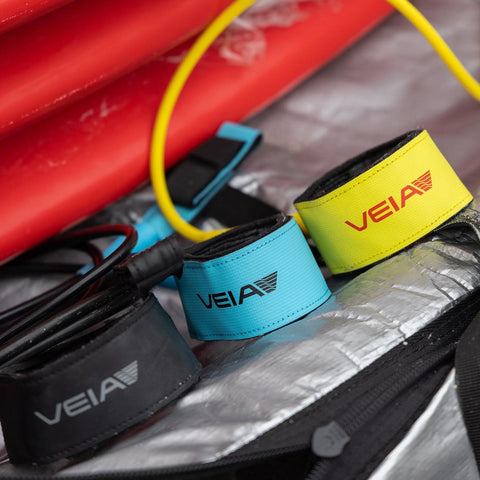How to Choose the Right Leash for Your Surfboard?

SHOP FCS LEASHES NOW
When it comes time to buy a leash, there are a lot of options available to you—not just in brands, but also in sizes and styles. What you buy depends on what type of waves and board you are riding.
Too short of a leash can snap your board back at you dangerously. Too thin might end up breaking. But too big of a leash will create the unwanted drag, slowing you down while paddling and riding waves.
In general, when riding smaller waves, try to use a leash that is roughly the same length as your board. Remember that larger boards are heavier and will pull harder on your leash, so a little extra length isn’t a terrible thing. Standard leash lengths include 6', 7', 8’, 9, 10', and super long leashes in the 12' to 20' range.
For most shortboards being ridden in small waves, you will likely want to use a 6' leash. While mini-guns (ridden in overhead+ surf) and mid-length longboards (“funboards”) might call for a 7’ or 8' leg rope.

SHOP DAKINE LEASHES NOW
Competition leashes are thinner than normal, and are used by advanced surfers who are less likely to fall, and who want less drag for increased speed. This is especially important in small wave competitions, which is how they get their names.
But it’s important to realize that a thinner leash is more likely to break, so this isprobably not the best option for everyday use, for use in larger, more powerful waves, or if you are a beginner and fall a lot. Longboard leashes are specifically made with noseriding in mind. They are long (often 9’ or 10’) to accommodate movement up and down the board, and sometimes come with a cuff built for your calf, rather than your ankle. This helps keep the leash out from under your feet while walking the nose.
Stand up paddleboards are heavier than normal surfboards, so SUP leashes need to be thicker and stronger. Leashes for SUP leashes should range from 8 to 20 feet in length and get the thicker leashes., usually 5/16”. They also sometimes include quick release pins that can be pulled in dangerous situations where you might want to be disconnected from your board, and are unable to pull against the leash hard enough to unstrap the cuff.
When attaching your leash to your board, it is important to do so properly to avoid damaging the board’s tail. Your leash string should be tied as short as possible to avoid hanging over the rail’s edge, while still loose enough to allow the leash to fit through it. A leash string that hangs over the tail will often cut into the rail during a wipeout, since it is strong and thin, and the rail of your fiberglass surfboard is relatively fragile.

SHOP VEIA LEASHES NOW
Remember that your leash string will stretch when it is wet and has tension on it, so you will want to go shorter than you first think. The only real exception to this rule is on a swallow tail board, which typically has the leash plug close to the center of the swallow tail, so the leash string will typically hang over.
When tying your leash string, the best thing to do is to fold it in half and tie an overhand knot, forming a loop around two inches in length. Insert the untied end of the loop into your leash plug, pull it through, then pull the knotted end through the loop and pull it snug. This will affix your leash string securely to your board, and leave a look that is roughly 1.5 inches in length—long enough to get your leash through, but not so long as to hang down over your board’s tail.
Watch Our Video On How To Put A Leash On Your Surfboard 👇👇
SHOP OUR LEASH COLLECTION
FAQ: Tips and Insights
How Often Should You Replace Your Surf Leash?
Regular inspection is key. Replace your leash if you notice any frays, tears, or other signs of wear. Generally, replacing your leash every season or after any signs of significant wear is a good practice to ensure safety.
How to Attach Your Leash Correctly?
Ensure your leash string is tied as short as possible to avoid hanging over the rail's edge, which can cause damage during a wipeout. Use an overhand knot to secure the leash string, ensuring it's tight and secure.
Should You Always Surf with a Leash?
Absolutely. Surfing with a leash is crucial for safety. It ensures your board is always within reach, preventing it from becoming a hazard to other surfers and helping you conserve energy in the water.
Which leash is recommended for protection against big waves?
The recommended leash for safeguarding against large waves is the FCS Protect Big Wave. This leash is specially designed to endure the powerful forces of big waves. It includes all the standard features present in the essential series leashes, but with enhanced durability and strength to offer additional protection.
What are the recommended wave sizes for the various leash options?
For surfers, it's important to choose the right leash based on the size of the waves. The FCS All Round Essential Leash is suitable for waves ranging from 2 to 8 feet in height. In contrast, the FCS Competition Essential Leash is intended for smaller waves, advising use for wave sizes from 0 to 4 feet.
Additionally, while the FCS Longboard Ankle Essential Leash does not have a specific wave size recommendation, it is specifically designed for use with longboards. The FCS Longboard Calf Essential Leash, similar to the ankle version, does not suggest a particular wave size but is uniquely designed to be worn around the calf for longboarding.
More To Read...
👉FCS II Fin Clinic by Hawaiian South Shore